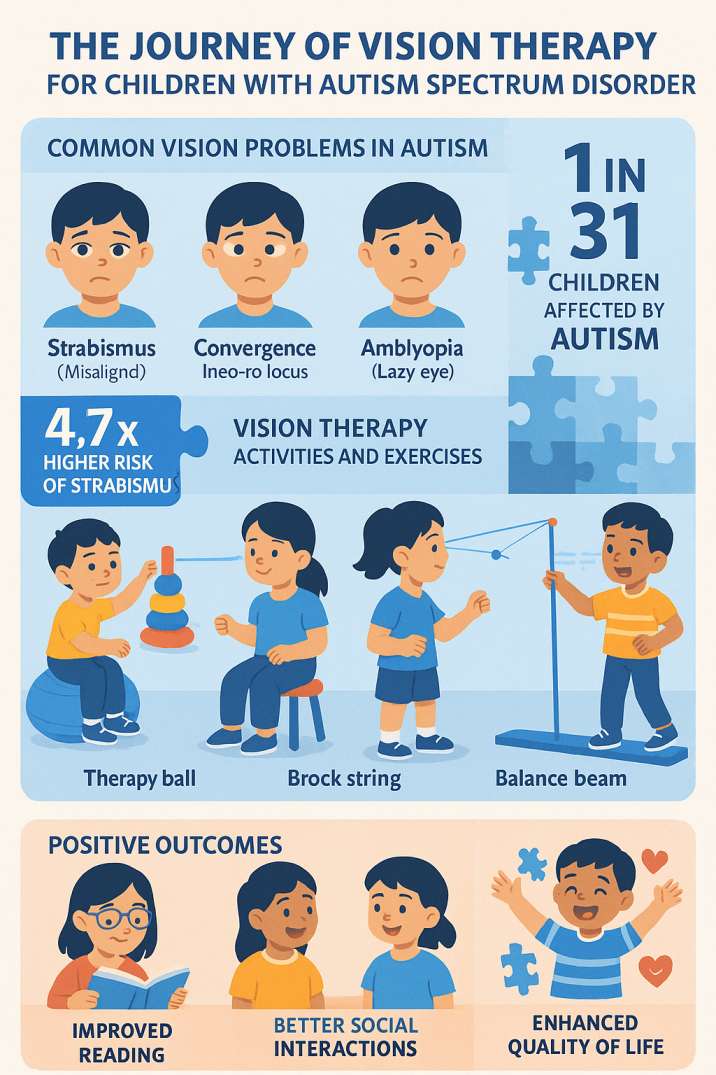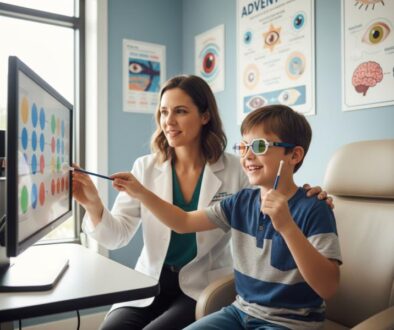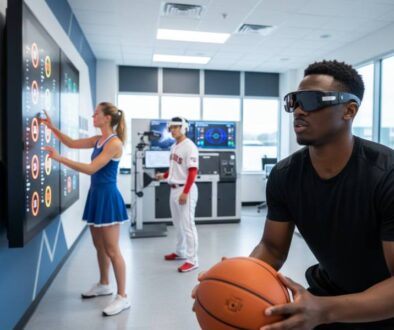Autism Spectrum and Vision: Understanding the Connection

The Hidden Truth: Up to 70% of children with autism spectrum disorder experience vision problems—a staggering statistic that challenges everything we thought we knew about autism. With 1 in 31 children now affected by autism (2025 CDC data), these visual challenges represent a fundamental piece of the autism puzzle.
For families watching their child struggle with social interaction or academic challenges, the connection between autism spectrum and vision problems offers both explanation and hope. This emerging research reveals that many behaviors we’ve labeled as “autistic” may stem from how the visual system processes information.
At Cook Vision Therapy Center in Marietta, Georgia, this understanding drives specialized care that addresses autism spectrum challenges and vision problems as interconnected aspects of the same condition. Rather than treating symptoms in isolation, this approach recognizes that transforming visual processing can unlock improvements across all areas of development.
The Scientific Evidence: Revolutionary Research Findings
Groundbreaking Statistics
The numbers are impossible to ignore: 48.4% of children with autism spectrum disorders have refractive problems, while an astonishing 70% experience some form of visual impairment. Compare this to the general population, where only 4% of children develop strabismus, yet over 15% of children with autism struggle with this eye alignment disorder.
Three Landmark Studies
Study 1: Comprehensive Meta-Analysis (2023). Published in Molecular Psychiatry, this systematic review analyzed 49 studies encompassing over 15 million individuals worldwide. The findings were unequivocal: definitive associations exist between autism spectrum disorder and multiple vision conditions.
Study 2: Large-Scale Population Study (2024) Taiwanese researchers examined 20,688 children with ASD alongside 2,062,120 matched controls, confirming elevated rates of hyperopia, myopia, astigmatism, and strabismus across the autism spectrum.
Study 3: Treatment Breakthrough (2024) A case report demonstrated measurable improvements in autism-related behaviors following targeted vision therapy interventions, validating approaches successfully implemented at Cook Vision Therapy Center for decades.
Understanding Autism Spectrum: Beyond Traditional Definitions
Autism spectrum disorder now affects approximately 1 in 31 children in the United States. Traditional autism characteristics include social communication challenges, repetitive behaviors, and restricted interests. However, emerging research reveals these observable behaviors may be adaptive responses to underlying sensory processing differences—particularly in visual processing.
Children on the autism spectrum frequently experience:
- Visual hypersensitivity to bright lights, busy patterns, or moving objects
- Visual hyposensitivity requires more intense stimulation for awareness
- Integration challenges between visual input and other sensory systems
- Attention and focus difficulties stemming from visual processing overload
Critical Vision Problems in Autism Spectrum Disorder
Strabismus: When Visual Teamwork Breaks Down
Strabismus affects more than 15% of children with autism—a rate three to four times higher than the general population. When eyes fail to work as a coordinated team, the brain receives conflicting visual information, creating challenges that extend far beyond vision itself.
Refractive Errors: Living in a Blurry World
Nearly half of all children with autism experience refractive errors, with hyperopia and astigmatism being most common. Myopia appears more frequently in children with Asperger syndrome, affecting nearly 18% of this population.
Amblyopia: The Hidden Problem
Recent studies reveal that more than half of children with autism have some form of amblyopia compared to children without autism. This “lazy eye” condition compounds existing visual processing challenges.
Visual Processing Disorders
Visual processing disorders involve problems translating visual information into thoughts or actions. These manifest as difficulty recognizing faces, problems with visual memory, challenges with visual-spatial relationships, and trouble with visual attention.
Impact on Daily Life
Academic Challenges
Vision problems can masquerade as learning difficulties or behavioral issues. Children may avoid reading, struggle with handwriting, have trouble copying from the board, or show fatigue during visual activities.
Social Communication Effects
Visual processing difficulties impact social communication, manifesting in challenges interpreting facial expressions and maintaining eye contact. What appears as social disinterest may reflect visual processing challenges.
Behavioral Manifestations
Many autism-associated behaviors may be adaptive responses to vision problems:
- Hand flapping near the face provides visual stimulation
- Looking at objects peripherally might be more comfortable
- Repetitive behaviors help organize overwhelming visual input
- Environment avoidance might reflect light sensitivity
Vision Therapy: A Transformative Solution
Evidence-Based Outcomes
Research demonstrates that vision therapy promotes better visual processing in children with ASD, allowing them to comprehend their environment with more certainty and subsequently improve behaviors like anxiety, social skills, and language skills.
Vision therapy can lead to:
- Improved eye movement control and coordination
- Better visual attention and focus
- Reduced visual sensitivity
- Enhanced visual-motor integration
- Increased comfort with visual tasks
Specialized Approaches for Autism
Vision therapy for autism targets sensory processing gaps, enhancing visual abilities like eye teaming and coordination using tools like ambient prism lenses to help individuals engage comfortably with their environment.
Cook Vision Therapy Center: Four Decades of Excellence
Pioneering Specialized Care
Cook Vision Therapy Center stands as Atlanta’s premier destination for autism and vision care. Dr. David Cook’s 40+ years of clinical experience, combined with Dr. Ekta Patel’s specialized training, create unparalleled expertise in addressing the relationship between autism and vision.
Revolutionary Treatment Approaches
Advanced Binocular Vision Training: Techniques that improve eye teamwork, reduce social gaze avoidance, and enhance visual comfort.
Sensory Integration Mastery: Utilizing ambient prism lenses to transform overwhelming visual environments into manageable spaces—crucial in busy Atlanta-area schools.
Real-World Integration: Practical sessions at locations like Swift-Cantrell Park and Cobb County schools, ensuring therapeutic gains translate into real-world improvements.
Individualized Protocols: Every program is tailored to specific sensory processing patterns, leveraging Marietta’s community resources.
Early Identification and Warning Signs
Parents should watch for:
- Avoiding eye contact consistently
- Preferring to look at objects from the side
- Covering or closing one eye frequently
- Sensitivity to bright lights or busy visual environments
- Difficulty with tasks requiring visual focus
- Unusual head positioning when looking at objects
- Visual stimming behaviors
Treatment Options and Collaborative Care
Comprehensive Approach
Effective treatment requires coordination between vision therapy specialists, occupational therapists, speech-language pathologists, educational professionals, and medical providers.
Prism Lens Technology
Prism lenses subtly move objects and images to where the brain expects them, boosting comfort and reducing anxiety and sensory overload.
Practical Steps for Families
Finding the Right Provider
Look for providers with autism experience, sensory-friendly environments, comprehensive assessment capabilities, and coordination with other care team members. Cook Vision Therapy Center meets all these criteria with specialized protocols developed over decades.
Preparing for Appointments
Choose experienced providers, schedule optimal times, bring comfort items, prepare the individual for expectations, and plan for multiple visits if needed.
Key Research Sources and Citations
1. Association between Autism Spectrum Disorder (ASD) and vision problems: A systematic review and meta-analysis
Molecular Psychiatry, 2023
https://www.nature.com/articles/s41380-023-02143-7
This landmark meta-analysis of 49 studies involving over 15 million individuals provides definitive evidence of the association between autism spectrum disorders and vision conditions.
2. CDC Autism and Developmental Disabilities Monitoring Network – Latest Prevalence Data
Centers for Disease Control and Prevention, 2025
https://www.cdc.gov/autism/data-research/index.html
The most current autism prevalence statistics show 1 in 31 children affected by autism spectrum disorder.
3. Vision problems common in children with autism – Research Review
Autism Research Institute, 2024
https://autism.org/vision-problems-common-in-children-with-autism/
Research findings show that 48.4% of children with autism have refractive problems and over 15% have strabismus.
Transforming Lives: A Call to Action
The connection between autism spectrum and vision represents hope and transformation for millions of families. With autism now affecting 1 in 31 children, understanding this autism-vision connection is critical.
The evidence is clear: vision problems may be fundamental to how autism develops and manifests. This understanding transforms our approach, moving beyond symptom management to address underlying sensory processing differences.
For families in Metro Atlanta seeking specialized care, Cook Vision Therapy Center offers unique expertise. Serving Marietta, Roswell, Alpharetta, Sandy Springs, and Cobb County, their individualized approach addresses the whole person within real-world environments.
When we treat vision problems as part of comprehensive autism support, we’re potentially transforming how individuals with autism experience and interact with their world, offering concrete steps toward meaningful improvements in quality of life, academic success, and social connection.
Transform Your Child’s Future Today
Ready to discover how vision therapy can unlock your child’s potential? Cook Vision Therapy Center in Marietta, Georgia, offers life-changing evaluations and treatment programs backed by four decades of excellence.
Call (770) 419-0400 for consultation scheduling.
Schedule your sensory-friendly evaluation designed for autism spectrum needs
FAQs
-
Many autistic people experience light sensitivity, visual processing difficulties, or visual snow, but experiences differ widely




